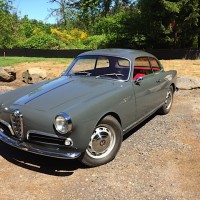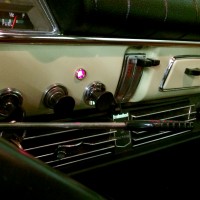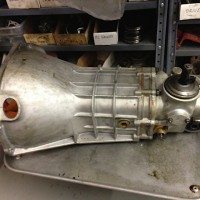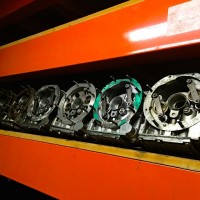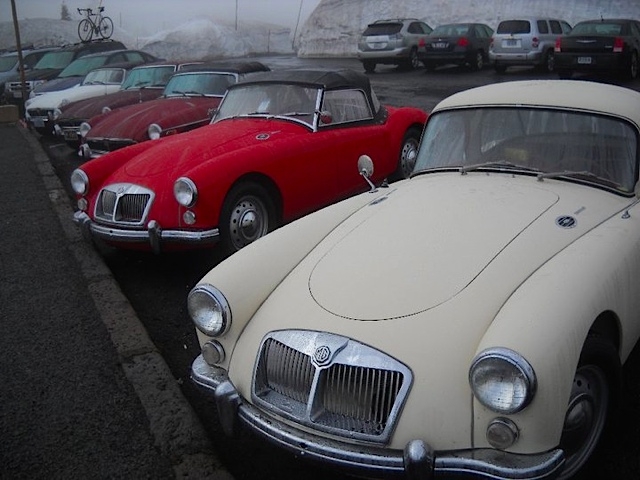
Should you upgrade the transmission on your vintage car?
That’s one of the debates in today’s collector car world. The discussions revolve around “as built” correctness versus upgrades for driveability.
Most of the small-displacement, under-2,000-cc vintage cars from the ’50s and ’60s handle, stop and start reasonably well. You simply adjust your driving style to accept the car’s limitations.
But there’s nothing you can do about engine speed on the freeway. If your car doesn’t have an overdrive or a fifth gear, you just have to accept the “automobile hell” of driving it on the Interstate. Your eyeballs will be vibrating for days after a 200-mile run at 4,500 rpm.
What is a Necessary Upgrade?
Before you decide to upgrade, the first consideration is the rarity of your car. The second is the degree of accuracy with which its original configuration can be established. The third is the message the modifications send to future collectors and automotive historians.
My own small collection includes a 1958 Giulietta Sprint Confortevole. The car is one of just 150 built. The data plate under the hood, which appears to be original, lists the chassis number and serial number of the engine that was installed when the car was built. So verifying that the car is “numbers matching” is possible. The gearbox and rear end appear to be original to the car, at least by the observed age of the components.
The Alfa Romeo Centro Documentizione has also provided a document that confirms the build date of the car, where it was first sold and its original exterior color.
I have a lot of the necessary information in hand to help me determine just how correct I want the car to be.
Because it is a limited-production car, I also have an obligation to the collecting community to make the car reasonably correct. For instance, I made the decision to rebuild the early-style “tunnel case” 4-speed gearbox. Finding the parts and the craftsman who could accomplish this was a more complicated process than sourcing and rebuilding a later “split case” 5-speed gearbox.
Twenty years ago, such swaps were done as a matter of course. It was expedient, inexpensive and real Alfa parts were involved. Later-production Giuliettas (starting some time in late 1958) got split-case transmissions from the factory.
Also, I had the presumed original 4-speed tunnel case tranny in hand. If there were already a splt-case 5-speed installed, I probably would not have gone to the trouble of sourcing a tunnel-case 4-speed.
The 4.1 rear axle (original to Veloces) makes the Alfa comfortable enough on the freeway, partly because the 1,300-cc twin-cam engine revs so freely. This car will not see a more-modern Alfa 5-speed while in my ownership. The tunnel-case is a part of its identity.
Add an Overdrive?
I see no problem in adding overdrive to a car that might have originally had one, even if your particular example doesn’t. For instance, I added overdrive to my 1967 Volvo 122S, replicating the factory installation down to the color of the indicator light in the dashboard.
How about adding a Volvo overdrive to a 544 — a car that never came with one? This is a slightly less-pure situation. But with nearly 250,000 544s built, adding an overdrive to one is not going to imply to a future historian that 544s had overdrives as a factory option.
Then we come to bastard conversions, such as putting an English Ford 5-speed gearbox into an MGA or Triumph TR3.
You could order a Triumph with an overdrive. I do understand that it is becoming more difficult to source overdrives and that installing one is not a matter of just slapping in a part. There are other modifications necessary, including adding a stalk to the steering column and the necessary wiring. Nonetheless, it can be done and is really the most correct way to make these cars cruise comfortably at high speeds.
Your options are more limited with the MGA, which never came with overdrive. The rear axle ratio was either 4.1 or 4.3, which with a pushrod engine means fairly high, buzzy revs on Interstates. One option is to go to a 3.9 rear axle from a later MGB. Make sure that your tires have the proper aspect ratio and height; putting a modern tire with a shorter sidewall on the car won’t help things.
But for me, putting a Ford 5-speed into one of these cars removes part of the essence of the vehicle. Giving an MGA the ability to go 70 mph easily is a good thing. Doing it by taking out a primary part of its original drivetrain is not.
Would I buy an MGA with a 5-speed installed? Well, that would remove me from the decision part of the equation, so I would not be responsible for the modifications. And with nearly 100,000 MGA roadsters built, there will never be a shortage of examples equipped with an original 4-speed.
My gut tells me that I would prefer an MGA with an original gearbox, 165×15 tires and a 3.9 rear axle. But I haven’t lived with either a modified one or an original, so I can’t really say.
If cruising at 75 mph were that important to me, perhaps I should just buy an MGB with an overdrive.
What I can say with certainty is that as our old cars become more “historical artifact” and less “daily driver,” we have to be more thoughtful about what changes we make to them. The equation includes how we want to use them, how many were made, and how “in spirit” the modifications are. Each car poses its own challenges and requires an individualized answer. But at the very least, you need to ask yourself the question, “Setting aside my personal comfort, am I helping or hurting this car’s future identity with these modifications?”
